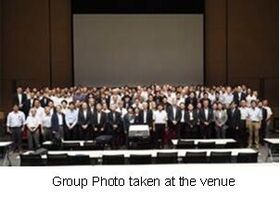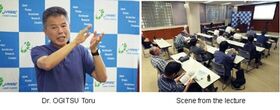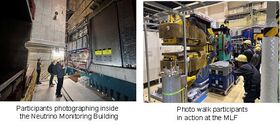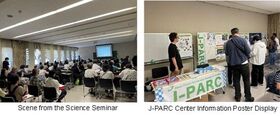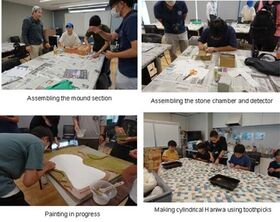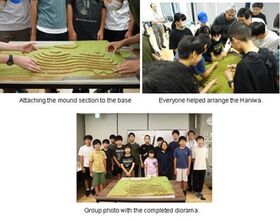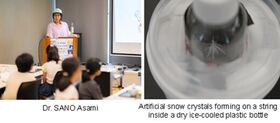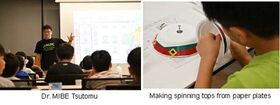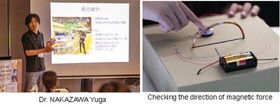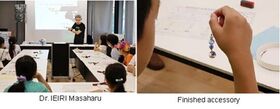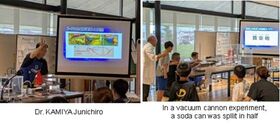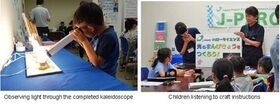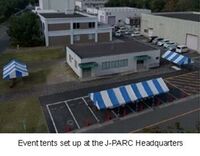J-PARC News August 2025 (Issue #244)
■Press Release
Discovery of Spin-Doped Ferromagnetism in Stress-Luminescent Semiconductors
— Paving the Way for Breakthroughs in Energy-Related Materials — (August 7)
Conventional percolation theory, which explains how connectivity within a material influences its properties, predicts that a phase transition cannot occur unless neighboring connections are sufficiently dense. Our latest research challenges this long-standing assumption. Using the muon beamline S1 at the Materials and Life Science Experimental Facility (MLF), we performed muon spin spectroscopy on EuXSr1-XAl2O4, a representative mechanoluminescent material that is intrinsically non-magnetic. Remarkably, we observed clear evidence of a transition to a ferromagnetic phase even when magnetic atoms (spins) were introduced in quantities far below the threshold predicted by percolation theory.
This groundbreaking discovery not only advances our understanding of condensed matter physics but also opens new frontiers in “mechanical–optical–spintronics.” By realizing spin-doped ferromagnetism in mechanoluminescent semiconductors, this work holds great promise for driving functional innovations in energy-related materials.
For more details (Japanese only), please visit the J-PARC website.
https://j-parc.jp/c/press-release/2025/08/07001601.html
■Neutron Industrial Application Report Meeting for FY2025
(July 17–18, Akihabara Convention Hall and Online Streaming)
In response to requests from industry, the Neutron Industrial Application Report Meeting aims to introduce cutting-edge measurement technologies and research results using neutrons and muons, with a strong focus on aligning these capabilities with industrial needs.
This year, 265 participants attended on-site and 123 joined online. The event featured two special lectures: one by Professor KOIZUMI Satoshi from CROSS and Ibaraki University, titled “Achievements of the Second Phase and Plans for the Third Phase of the Ibaraki Prefecture Beamline,” and another by Professor SUGIYAMA Masakazu from the University of Tokyo, titled “Materials Research Based on Data Generation and Utilization” Alongside these keynote presentations, the program also included general talks and poster sessions, which fostered active discussions throughout the event.
■J-PARC Hello Science: “Magnetic Fields Created by Superconducting Magnets” (July 25)
Dr. OGITSU Toru from the Cryogenics Section introduced the history of superconducting magnets used in large-scale accelerators, along with the unique phenomena associated with superconductivity.
Discovered approximately 115 years ago, superconductivity exhibits fascinating behaviors such as the Meissner effect and flux pinning. Because superconductors have zero electrical resistance, they are highly effective for use in large accelerators that require high-power electricity and have been extensively studied and utilized in the development of accelerators.
The presentation also covered phenomena unique to superconducting magnets in large-scale accelerators, including variations in sextupole components during beam injections and error magnetic field that arise during acceleration.
■J-PARC Photo Walk 2025 (July 19)
J-PARC held its first photo walk, joining the Global Physics Photo Walk—an international initiative involving leading accelerator research institutes around the world. This event featured two exclusive shooting locations: the Materials and Life Science Experimental Facility (MLF) and the Neutrino Monitoring Building. From a large pool of applicants, nine participants were selected by lottery to explore and photograph experimental areas that are normally inaccessible to the public. This rare opportunity allowed them to experience cutting-edge research up close, capturing the unique atmosphere of J-PARC through their own lenses
Three photos taken and submitted at J-PARC have been chosen as representative entries. They will be part of a global vote together with submissions from other major research institutes.
■Geo Space Adventure (GSA 2025) Science Seminar (July 26)
Geo Space Adventure (GSA), a popular underground science exploration event, was held in Hida City, Gifu Prefecture. Participants enjoyed a rare opportunity to visit world-renowned research facilities, including Super-Kamiokande and KamLAND, an antineutrino detector operated by Tohoku University.
As part of the event, a science seminar was held at the Kamioka Town Community Center, where Dr. HINO Yota from the Neutrino Section gave a lecture titled “Unveiling the Secrets of the Universe with the J-PARC Neutrino Beam from Tokai Village!”
The seminar drew 78 attendees in the morning session and 36 in the afternoon. Participants showed a strong interest in neutrino research, asking numerous questions about topics such as the speed of neutrinos and the upcoming Hyper-Kamiokande experiment.
■Muographic Investigation of Ancient Burial Mounds in Tokai: Creating a Diorama of Funatsuka No. 2 Burial Mound(July 27)
On the first weekend of summer vacation, 14 elementary and junior high school students took part in the third session of the Muographic Investigation of Ancient Burial Mounds in Tokai for 2025. This session focused on two main activities: reporting on the status of muon imaging with the first detector and creating a 1/100-scale diorama of the Funatsuka No. 2 burial mound. Through these activities, participants deepened their understanding of burial mounds and survey maps and used the diorama to explore installation sites for the second muon detector.
The program began with a presentation by Dr. FUJII Yoshiaki from the Particle and Nuclear Physics Division on how muography is used to visualize burial mounds. Next, Mr. KUZUHA Masaya from the Graduate School of Ibaraki University explained the current status of data analysis from the muon detector, the “Detector for History and Future.”
During the diorama-making session, participants split into three groups: one assembled the stone chamber and detector, another painted the mound and base, and the third made tiny cylindrical Haniwa dolls. The third group was guided by Professor TANAKA Yutaka at the College of Humanities and Social Sciences, Ibaraki University, observed actual cylindrical Haniwa excavated from Funatsuka No. 2. They learned about the features, roles, and placement of the Haniwa on the mound before crafting cylindrical Haniwa for the diorama.
To conclude the day, Dr. FUJII explained the conditions required for installing the detector. Using the completed diorama, the team narrowed down the candidate sites for the second detector to two locations. The final decision will be made after on-site confirmation of feasibility.
The completed diorama was later exhibited at the “J-PARC and Nuclear Science Research Institute Open House 2025” held on August 23.
■Tokai Village Enjoy Summer School 2025 (July 29–30 and August 2, Tokai Village Museum)
The science experiment workshop was held this year, engaging elementary school students through a collaborative initiative involving schools and organizations in Tokai Village.
As part of the J-PARC Hello Science Summer Science Experiment Workshop, we offered activities such as “Tilted but Won’t Fall! The Mystery of Spinning Tops,” “Let’s make accessories with hadrons,” “Transforming Water – Let’s observe Snow Crystals.” and the team Getapon(Nobu-chan Sensei & Dr. KAMIYA) presents: “What is Air and Vacuum? Part II”.
This year was the first time that “Transforming Water―Let’s Observe Snow Crystals” took place, in which participants built a Hiramatsu-style artificial snow generator. They moistened the inside of a plastic bottle, suspended a string with a small weight, and cooled the entire bottle using dry ice. This setup allowed them to observe how ice crystals―resembling snowflakes―gradually grew around the string. The workshop also featured an experiment showing how applying high pressure to water can produce a special form of solid water, known as high-pressure ice. Unlike ordinary ice, this phase has a unique molecular structure and remains stable only under extreme pressure.
Survey responses reflected participants’ amazement at their discoveries, with comments such as: “I was surprised that ice can form just by applying pressure, without lowering the temperature!” and “I didn’t expect high-pressure ice to appear so suddenly!”
●July 29
Transforming Water – Let’s observe Snow Crystals.
●July 29
Spinning Tops: Tilted but Balanced!(For Elementary Grades 1-4)
●July 30
Spinning Tops: Tilted but Balanced!(For Elementary Grades 5-6)
●July 30
Let’s make accessories with hadrons.
●August 2
The team Getapon(Nobu-chan Sensei & Dr. KAMIYA) presents: “What is Air and Vacuum? Part II”
■Children’s Kasumigaseki Open Days "Let’s Make a Kaleidoscope of Light" (August 6–7)
The “Children’s Kasumigaseki Open Days” is an event organized during summer vacation by the Ministry of Education, Culture, Sports, Science and Technology (MEXT) and other government agencies located in Kasumigaseki. The event aims to help children learn more about society.
At the Japan Atomic Energy Agency booth within MEXT, children were introduced to J-PARC and participated in a craft workshop where they made a kaleidoscope of light. When they looked through their completed kaleidoscopes, the light sparkled in rainbow colors, and their faces lit up with joy. One child even wrote “J-PARC” on the back of their hand to remember it.
■J-PARC Sanpo-michi 61 The Night Before the Open House Day
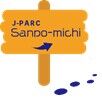
Tonight, there is no moonlight, no breeze—only the steady chirping of crickets at our feet.
It has been exactly one month since the last issue of this column. During that time, Mito City endured temperatures above 30°C almost every day, save for two brief spells of rain. Yet under the clear night sky, the sound of autumn insects quietly reminds us that the season is on its way.
Since January, our Open House Committee has worked tirelessly-revising plans, fine-tuning details, and preparing for tomorrow’s big event. The tents are already in place, with tables and chairs stacked neatly inside, awaiting assembly in the morning. Inside the J-PARC Research Building, exhibits on the second and third floors rest under the soft glow of lights streaming from the atrium above. Imagining these spaces bustling with visitors tomorrow makes tonight’s calm feel even more profound.
For us, the night before J-PARC’s largest annual event is always a special one-a rare stillness that carries a quiet thrill, a reminder of the effort behind us and the excitement that lies ahead.

